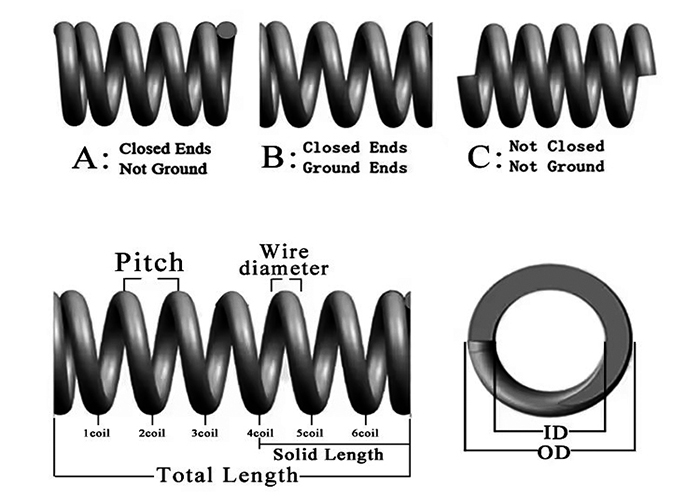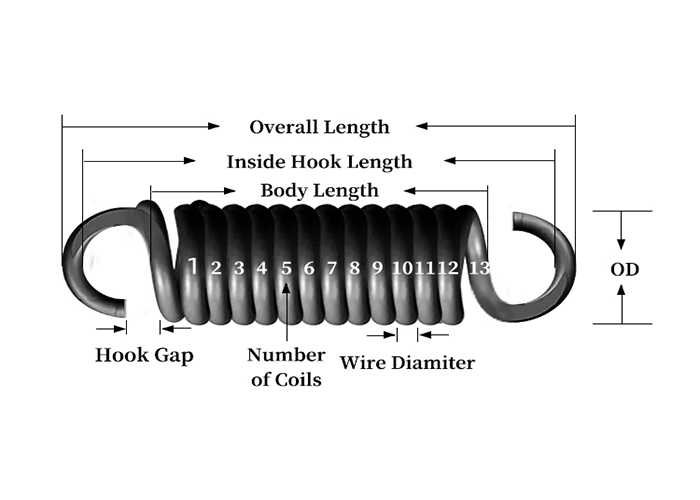At Makeway Spring, we have experience with all types of die springs. All our springs are built to the highest standards to operate above industry standards and are used in machinery including farm machinery and 3D printing.
Spezifikationen für Kohlenstoffstahl: MK-65MN-DS01 、MK-65MN-DS02、MK-65MN-DS03、MK-65MN-DS04、MK-65MN-DS05
Alloy Specifications: MK-AS-DS01 、MK-AS-DS02、MK-AS-DS03、MK-AS-DS04、MK-AS-DS05
Factors that are important while choosing which die spring is best for your project:
By purchasing through Makeway Spring you will have the best product for various applications.Contact us at any time and one of our customer service team members can help you out with your custom order or request an estimate below.



Wir sind in der Lage, unseren Kunden kundenspezifische Druckfedern zu liefern, die nahezu jede Spezifikation erfüllen

In the world of heavy machinery and industrial applications,precision is paramount.At Makeway Spring,our die springs undergo rigorous testing to guarantee impeccable performance.
In the world of heavy machinery and industrial applications,precision is paramount.At Makeway Spring,our die springs undergo rigorous testing to guarantee impeccable performance.
Belastungstests:
This test involves subjecting the die spring to different loads to verify that it can compress and return to its original position without deformation or failure. It ensures that the spring can handle the expected loads in the application.
Deflection Testing:
This test measures the spring’s deflection under a specified load. It helps determine the spring’s behavior when subjected to a particular force and ensures it meets the design requirements.
Stress and Strain Testing:
This involves evaluating the spring’s response to applied stress. It helps determine the spring’s elastic and plastic deformation behavior and ensures it can handle the expected working conditions.
Materialanalyse:
Testing the material properties of the spring, including tensile strength, yield strength, and composition, ensures it meets the specified standards for the application.
Die Spring design is not always one-size-fits-all. We at Makeway Spring pride ourselves on having the best engineers and top-notch customer service. No other manufacturer will offer you better service and when you need custom springs made, our team is clutch. We work hard so you can be sure your custom heavy duty metal Die springs.

ie springs,built for heavy machinery,use high-quality alloyed steel for superior load-bearing.Essential for industrial machines,proper selection and maintenance are key for longevity.They come in various configurations to suit different needs.
Die springs are heavy-duty compression springs that are commonly used in die machinery,stamping presses, and other heavy-duty industrial applications.They are designed to withstand high load and provide reliable and consistent performance.
Die springs offer several benefits,including high load-bearing capacity,long service life,efficient energy absorption,and resistance to fatigue and wear.They provide consistent force throughout their working range and are available in various sizes and force ratings to meet specific application requirements.
When selecting a die spring,you need to consider factors such as the required load capacity,working environment conditions, spring size and type,and the desired deflection and force specifications.It is recommended to consult with a spring manufacturer or engineer to ensure you choose the right spring for your application.
Die springs are often color-coded to distinguish between different force ratings.The commonly used color codes are lightest load (blue), light load (yellow),medium load (red), heavy load (green),extra-heavy load (brown), and ultra-heavy load (purple).
Yes, die springs can be customized to meet specific load capacities,sizes,and force specifications.Customization options include altering the outer diameter,inner diameter,wire size,and length to suit your application needs.
The lifespan of die springs depends on several factors,such as the application’s operating conditions,load profile,and proper maintenance.However, die springs are designed to have a long service life and can withstand millions of cycles under normal operating conditions.
Die springs are primarily designed for heavy-duty industrial applications.While they may be used in some non-industrial applications,it is recommended to consult with a spring manufacturer or engineer to determine the suitability of die springs for your specific application.
Yes,Makeway Spring can handle orders of all sizes,from small to large.Whether you need a single die spring or a large quantity for your production line,we can provide customized solutions to meet your specific needs.
Vom ersten Federentwurf bis zur Fertigung und Lieferung. Unsere bewährten Verfahren und unsere Qualitätssicherung gewährleisten, dass Sie präzise Teile erhalten, die speziell für Ihr Projekt gefertigt wurden. Jede Lösung ist auf Ihre Bedürfnisse zugeschnitten.

Druckfedern sind ein gängiger Federtyp, der Druckkräften standhält. Diese Federn sind typischerweise gewickelt und werden häufig in Anwendungen wie Fahrzeugaufhängungen, Industriemaschinen und elektronischen Geräten eingesetzt.

Werkzeugfedern sind für Anwendungen mit hohen Belastungen konzipiert und werden häufig in Stanzwerkzeugen und Werkzeugsätzen verwendet. Diese Federn bestehen üblicherweise aus hochfestem legiertem Stahl und bieten dadurch eine höhere Druckfestigkeit und eine längere Lebensdauer.

Zugfedern speichern beim Dehnen Energie und kehren beim Entspannen in ihre ursprüngliche Form zurück. Sie werden häufig in Anwendungen wie Türschlössern, Spielzeug und mechanischen Geräten eingesetzt. Zugfedern haben typischerweise an beiden Enden Haken zur Befestigung.

Kopflose Zugfedern ähneln herkömmlichen Zugfedern, haben jedoch keine herkömmlichen Haken oder Enden. Diese Federn werden in Anwendungen eingesetzt, die spezielle Befestigungsmethoden erfordern, um die Konstruktionsanforderungen zu erfüllen.

Uhrfedern, auch Antriebsfedern genannt, sind Spiralfedern zur Speicherung mechanischer Energie. Sie werden häufig in Uhren, Spielzeugen und anderen Geräten verwendet, die Energie speichern müssen. Diese Federn können manuell oder mechanisch aufgezogen werden und geben dann Energie frei, um mechanische Geräte anzutreiben.

Torsionsfedern sind so konstruiert, dass sie Drehmomenten oder Rotationskräften standhalten. Diese Federn werden häufig in Klammern, Schaltern, Garagentoren und anderen Geräten verwendet, bei denen Rotationskräfte wirken. Durch die Drehung wird eine Gegenkraft erzeugt.

Messingfedern bestehen aus Messing und bieten hervorragende Korrosionsbeständigkeit und elektrische Leitfähigkeit. Sie werden häufig in Anwendungen eingesetzt, die Korrosionsbeständigkeit oder elektrische Leitfähigkeit erfordern, wie z. B. in elektrischen Schaltern und Klemmen.

Drahtformen umfassen verschiedene Federn und Teile, die durch Biegen von Metalldrähten geformt werden. Diese werden für spezifische Anwendungen maßgeschneidert und können in komplexe Formen gebracht werden, um in einzigartige mechanische oder elektronische Geräte zu passen.
Erhalten Sie Angebote und Produktinformationen aus erster Hand, wir stehen Ihnen bei allen Anfragen rund um die Uhr zur Verfügung.
info@makeway-llc.com
+86 755 28459980
Zimmer 1510, Gebäude 13 Huanancheng, Nr. 1 Ping'an Avenue, Bezirk Longgang, Shenzhen, Guangdong, China